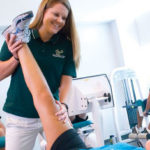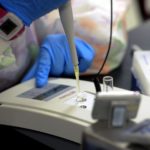Computer science alumnus works on NASA project
In 1969, walking on the moon was considered “one small step for a man, one giant leap for mankind.” In 2013, it’s possible that this statement may be recapitulated as “one small step for a humanoid, two giant leaps for mankind.” University of West Florida alumnus John Carff, a research associate at the Florida Institute for Human and Machine Cognition, is working with a small team of FIHMC employees to make this a reality.
NASA contracted the Institute to work on developing walking algorithms for a two-legged version of NASA’s “Robonaut” humanoid robot. This project is a precursor to “Project M”, a proposed project to develop and land an operational humanoid robot, also referred to as R2, on the moon in 1,000 days. Scientists would control the robot from Earth through various user interfaces, ultimately allowing researchers to study the lunar surface virtually. Carff’s team consists of researchers from both NASA Johnson Space Center and FIHMC and is led by FIHMC Research Scientist Jerry Pratt. Besides developing the walking algorithms that will run the robot, they also are developing simulations that will provide information about motor requirements and lower body dimensions to the NASA engineers who are designing the lower body. Carff said the most challenging aspect of the project for him has been understanding how gravity affects the way people walk.
“We have had to learn new ways to walk on the moon, just as the astronauts did when they went there,” he said. “We have successfully enabled our current robot, named M2V2, to walk in Earth gravity, but dealing with moon gravity has been more difficult. On Earth, our robot weighs about 80 pounds and can handle significant disturbances. In moon gravity, our robot would weigh about 13 pounds, so even a slight disturbance could push the robot off balance.”
Many robotics experts consider humanoid robots to be one of the defining technologies of this century and think it will be as significant for this century as the automobile and personal computer were for the last century. According to the NASA Web site, if the project becomes fully vetted and funded, the plan is for the robot to walk on the surface of the moon as a technology demonstration and lead to future robots that may perform a multitude of engineering tasks.
Carff’s team started working on the project at the beginning of 2010. Regardless of final funding, the team’s work will continue until early 2011. The federal government will vote on the final funding for Project M around the end of this year.
For many engineers, working for NASA is the ultimate dream come true. Carff is living the dream, and only one year after receiving his master’s from the university.
“My education and experience at UWF has prepared me to work on a project like this by teaching me to try new things and to always do my best,” said Carff. “I worked on a wide variety of projects at UWF, including my recent master’s project that used augmented reality to navigate robots around urban environments. The paper I produced from that project was published and accepted in to a robotics conference last year.”
Carff also received his bachelor’s degree in computer science at UWF, as did his three brothers. Even his sister graduated from UWF.
“The main reasons we chose UWF were the computer science program and great location,” he said. “My family and I all agree—UWF is a great place to go to school.”
For more information about Project M, visit robonaut.jsc.nasa.gov. For more information about IHMC, visit ihmc.us. To see recent IHMC robots in action, visit robot.ihmc.us To learn more about the UWF computer science program, visit uwf.edu/computerscience.
By Lauren Smith, University Marketing Communications


